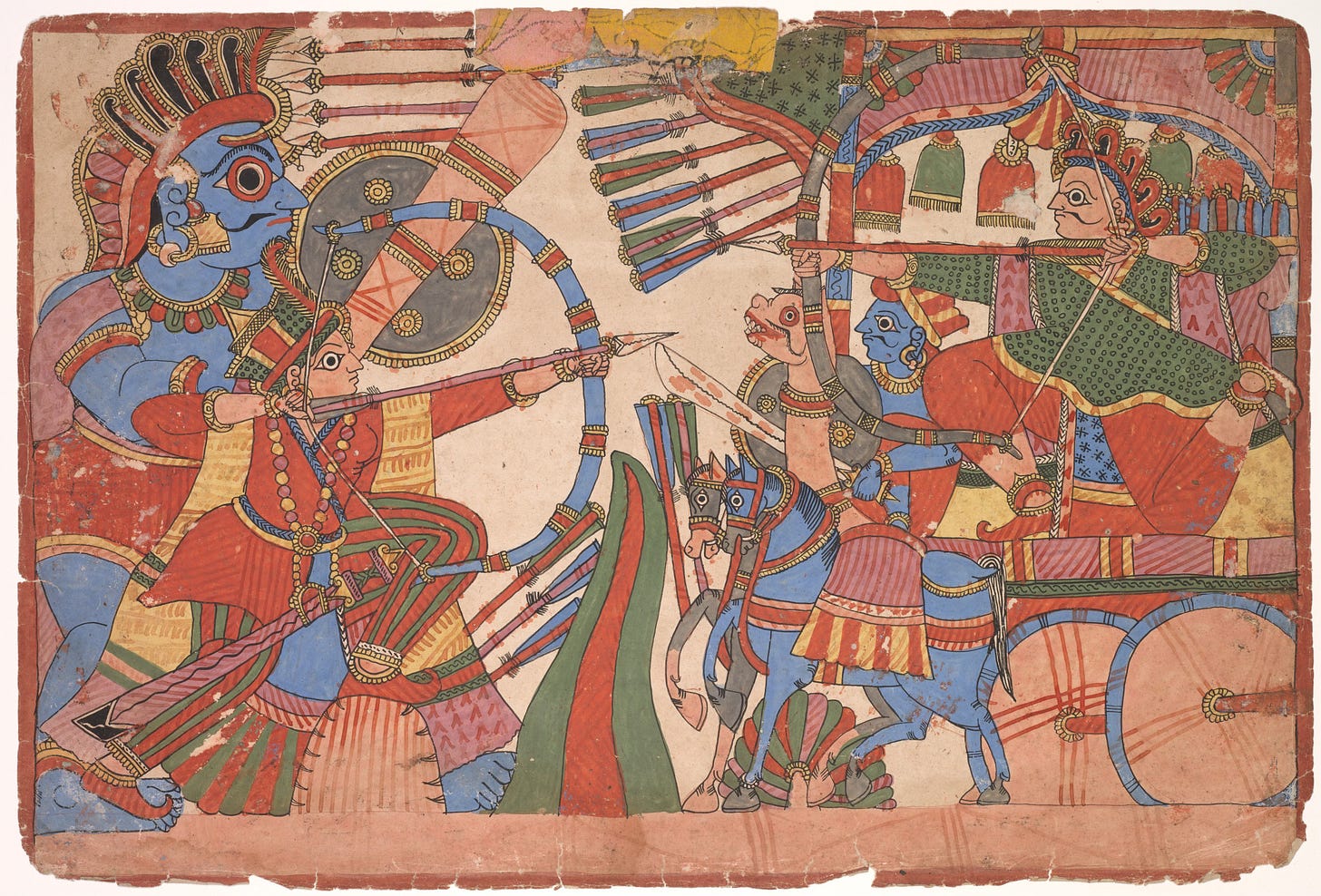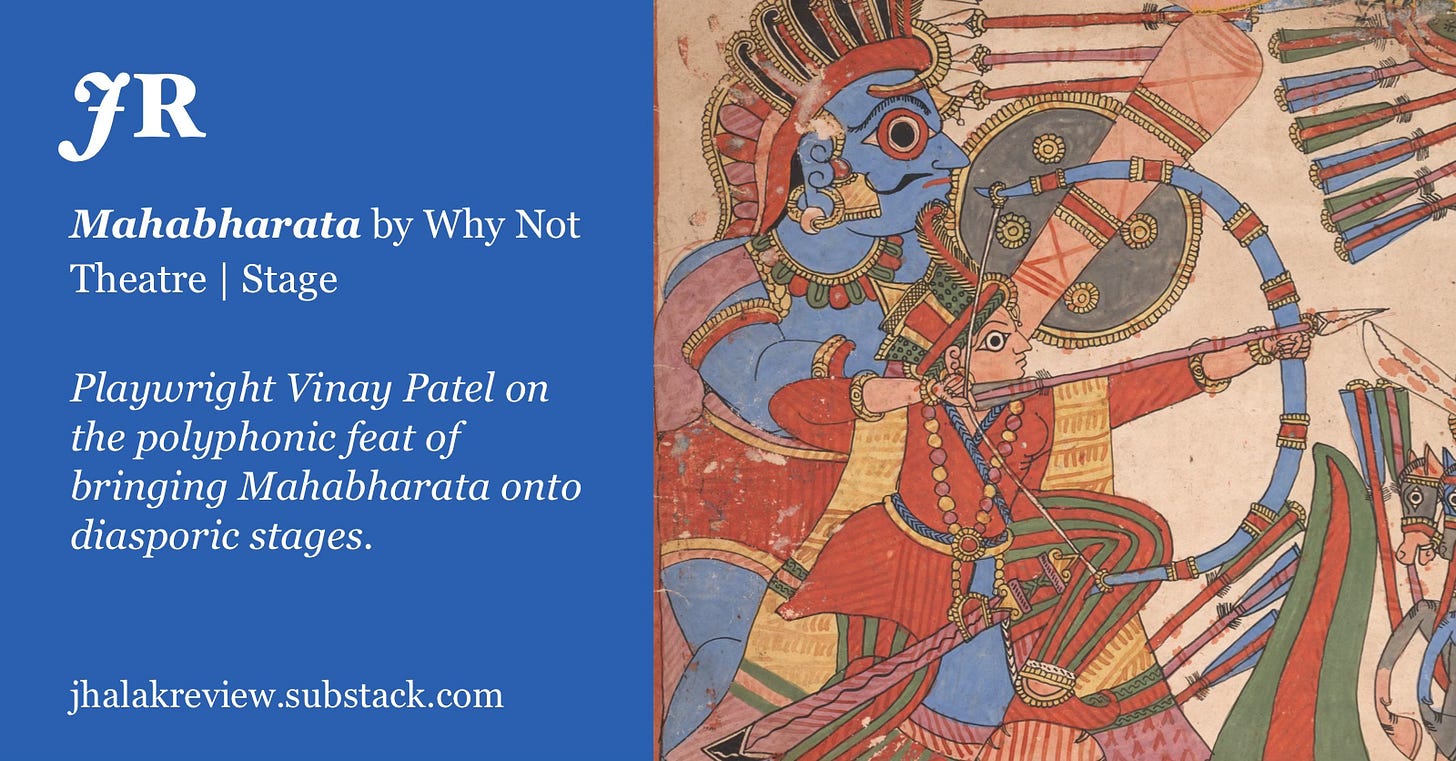Mounting ancient epics onto diasporic stages
Vinay Patel on Mahabharata, adapted for the stage by Miriam Fernandes & Ravi Jain, Directed by Ravi Jain, Presented at the Barbican Theatre
Review by Vinay Patel | Originally published in the print edition, October 11th 2024
As a child of the 90s, there were three ways I first encountered the Mahabharata - comic books, snatched snippets from my grandmother watching Indian TV adaptations, and my grandfather’s tellings across the kitchen table.
Early last year, the Barbican announced a production of Mahabharata by the Canadian South Asian diaspora company Why Not Theatre. I was tantalised to see this Sanskrit epic of duty and morality told with ambition. However, when presenting narratives that centre people from diaspora communities, theatre has a habit of seeking digestibility above all else. Unfamiliar bodies weigh heavy on the scales of accessibility.
There are brilliant exceptions, most memorable of late was S.Shakthidharan’s Counting and Cracking. A three-and-a-half hour multilingual saga ranging from 1950s Colombo to modern day Sydney, it enthralled precisely because it was allowed to embrace its size and specificity.
Walking into this production, I had hopes for a similarly galvanising experience. Yet when the first part began and Miriam Fernandes, in the role of Storyteller, joked to the audience “Don’t be confused by plots”, it felt like a familiar succumbing to digestibility. This most ancient of tales having to apologise for its complexity and tamp down its seriousness.
This was not, I suspect, the experience of watching English director Peter Brook’s revered dusk-to-dawn Mahabharata forty-odd years ago. However, contemporary Indian critiques insisted Brook’s adaptation could not possibly hold the soul of its source, that the production’s dramaturgy, its philosophical basis was inescapably Western. In its search for universality, it had separated the Mahabharata from its context as a cornerstone of Indian culture, leaving it with the quality of a trivialised, inauthentic fairytale.
Diasporic storytelling can similarly find itself stuck in an unsatisfying in-between. Neither familiar in the ‘new’ culture nor authentic to the ‘old’. So this charge can also be made against this new attempt, especially as director Ravi Jain speaks about Brook’s influence on his practice.
What becomes clear is that Why Not Theatre’s adaptation makes the charge part of the gesture. Fernandes and Jain, like myself, first encountered the Mahabharata through oral and pop-culture adaptations. Each medium telling the same story while carrying different intentions and possibilities for different audiences. Appropriately, rather than aiming for an impossible authenticity or contentious universality, this Mahabharata takes stories that have been passed down as a beloved but scattered inheritance and rebuilds them into a version that reflects the thematic concerns of the theatre- makers. It also demonstrates how it has been shaped by artistic practices beyond the places of their origins.
In Part One (Karma), the storytelling form is that of a traditional fireside tale that morphs into a version of ‘poor theatre’, where props and objects are mimed. The influence of Lecoq (an avant- garde physical theatre school where Fernandes and Jain trained) is most evident here, but so too is the sense of more classical Indian forms of ritual and physicality. Each performance starts with a pranam, a reverential salutation, and uses dance forms such as Kathakali and Odissi as part of its evolving narrative. There’s an elemental power to this mix that foregrounds the play’s focus on how the tussles of the powerful wreak havoc on the environment around them.
As we move into Part Two (Dharma), war looms - the spectre of total destruction with it - and modern Western theatrical frameworks begin to take precedence. Live cameras, screens and projections invoke Ivo van Hove’s groundbreaking Roman Tragedies, as well as the work of
Complicité, known for their fusion of Lecoq sensibilities and technological dazzle. Eastern forms are still present and though the staging becomes more contemporary, aspects of the ancient such as the costumes and fire remain.
While the inevitable battle is thrillingly staged, the emotional vivacity of Part One gives way to greater detachment and philosophical inquiry. If this is somewhat anathema to classical dramatic structure, it also felt familiar to the story that I knew. There are moments when the approach is less effective. Krishna’s divine revelation to Arjuna, performed as an operatic aria, is more aesthetically stunning than spiritually profound.
For the most part, though, this Mahabharata is a charming work of polyphonic theatricality that seems to respond to those who might object to overseas cousins fumbling with something so profoundly rooted by saying “who understands the cycles of upheaval, anxiety and rebirth that Mahabharata speaks to more than a diaspora?”. In shifting its form as it goes along yet retaining parts of the styles it’s already used, the production creates a palimpsest familiar to the displaced who know in their bones that the past is never dead, their fates are not always in their hands and the material world is transient.
The play ends with the words “Om Shanti Shanti Shanti”, an evocation of peace my grandfather would whisper to child-me in an attempt to swing my restless mind towards sleep. I’m reminded that I’m a version of that long-departed man. In a different time, a different cycle, but grappling with similar moral questions and carrying stories far older than me. Stories that will go on being told in ways that, while not yet known to us, will hold the myriad truths of those doing the telling.






